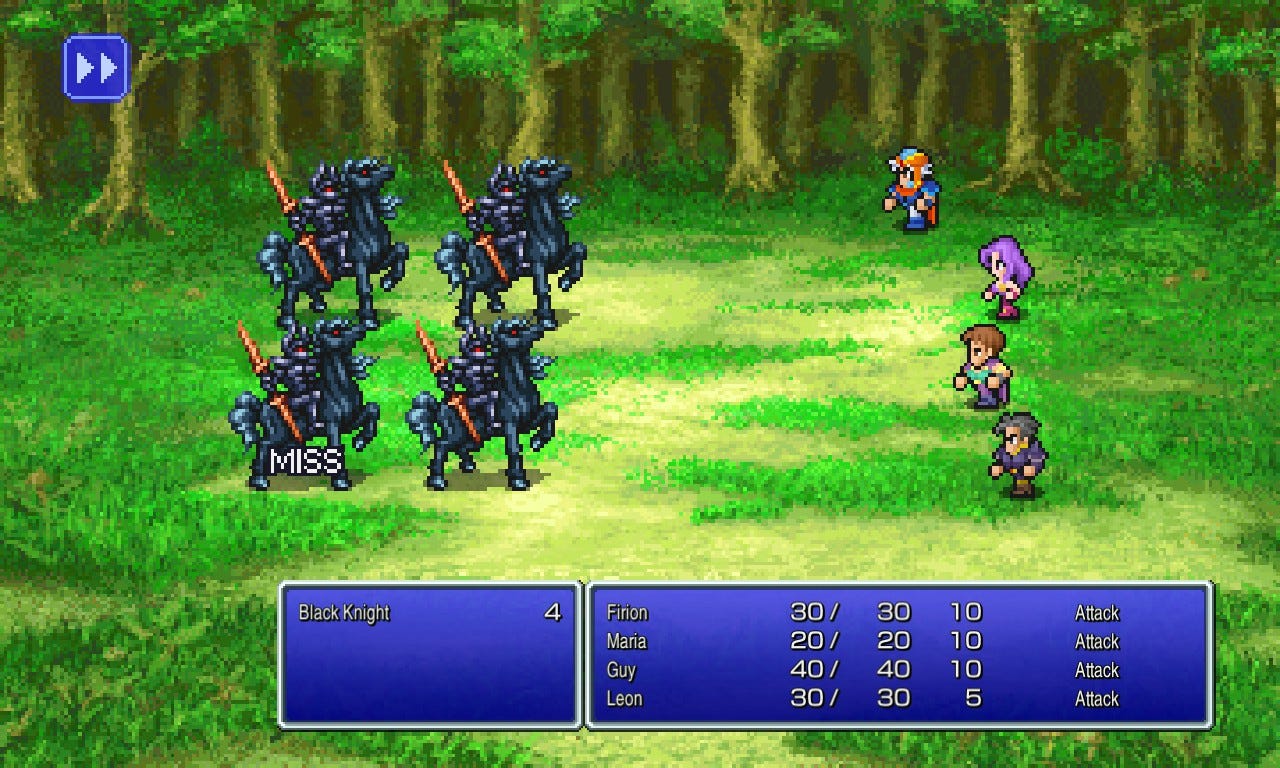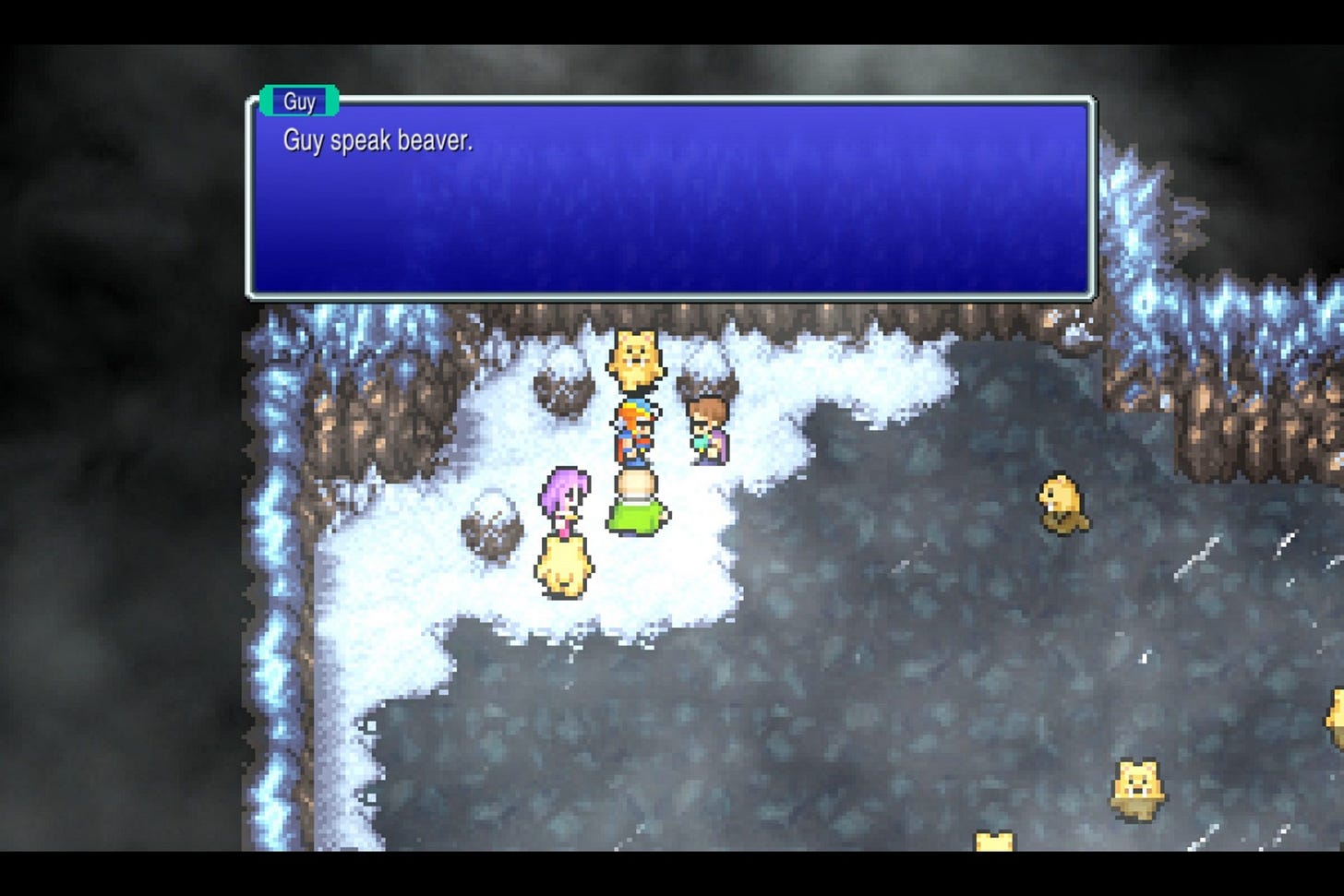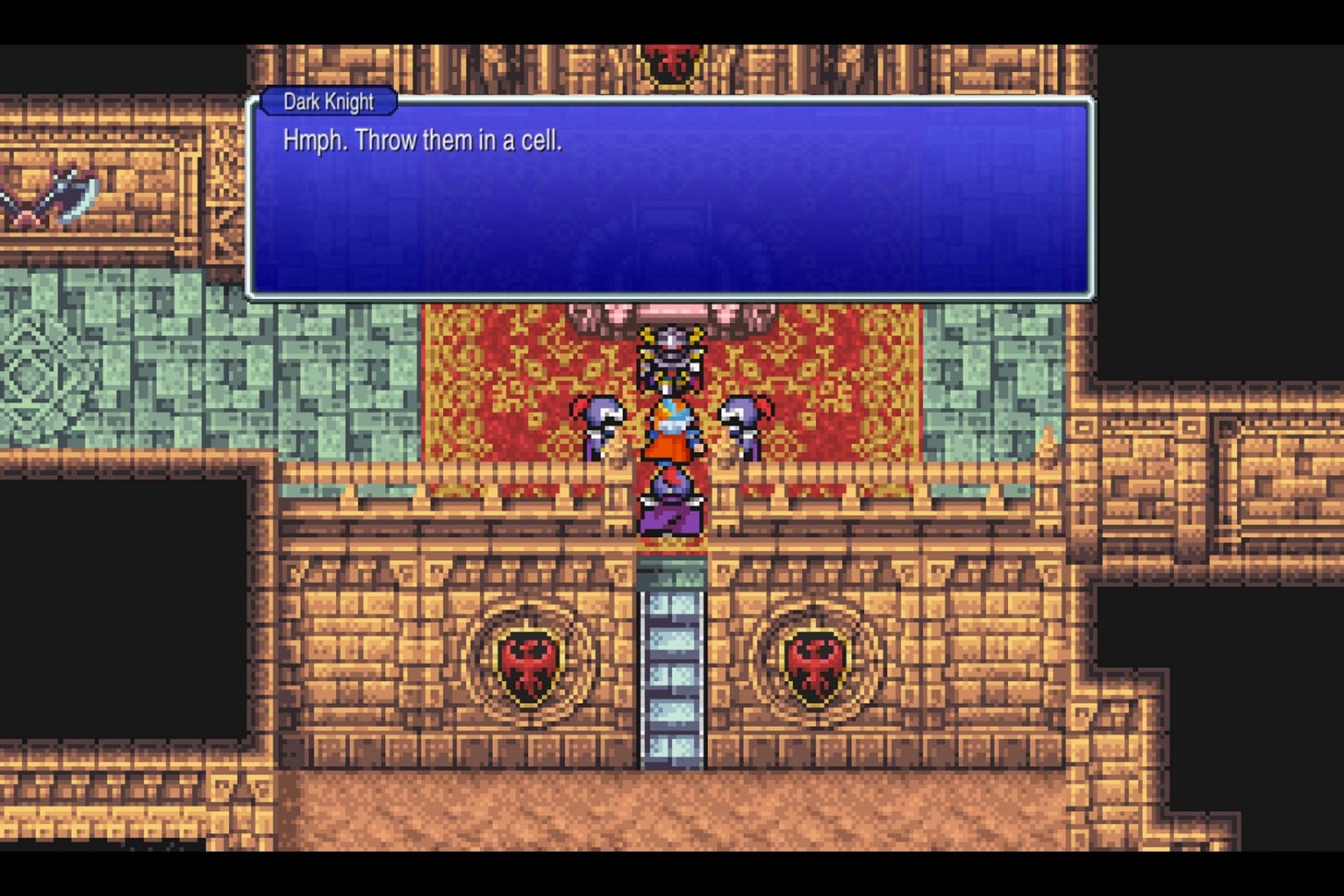In the same way as Final Fantasy, it was with Final Fantasy Origins that I came to enjoy Final Fantasy II. It is a game I enjoyed more than the first, though I’ve played through it less, mainly due to getting too caught up in the customising and not enough in the progression.
Anyway, often considered the second of the mainline Final Fantasy games, Final Fantasy II exists. It also exists as the second of six in the pixel remaster re-releases; a series that focuses on nostalgia, but not without some updates. It also has been a somewhat controversial title in the Final Fantasy series due to how it approached certain aspects of gameplay.
The plot is thus: Forsooth! The Emperor of Palamecia is conquering the world. Your plucky heroes join THE REBELLION as they want to stop The Emperor. From there you cycle through furthering the plot, traveling to locations, a bit of dungeoneering and some other stuff.
After starting a new game the first thing you do is lose a fight whilst you’re trying to run away from The Palamecian Empire. At this point in gaming an unwinnable fight is not the rarest of things in RPGs, but its implementation here works well as it establishes The Empire as a conquering and overwhelming force. This then extends into the subsequent few scene which establish the characters’ will to fight back against said force, despite the odds being against them. It’s not exactly deep or complex stuff, but it feeds well into the narrative.
Final Fantasy II makes use of a keyword system. Its a system where you can learn, then “say” certain words in certain conversations to certain characters. They’ll get you more information about a current situation as well as further the plot, but once you pass the point where the most recently learned words see use, the game tends to forget about them. I believe there’s one place where you can use keywords just for information, and there’s some that may have additional use after their relevant sections, but that’s about it. It’s a shame how limited it is, as the system is interesting and has a lot of potential.
The world’s design is fairly open for the most part; Once you leave the first town you can freely explore, but the story always progresses in a specific order. Exploring might see you encounter enemies much stronger than your party; it can also get you access to some powerful stuff early on. The layout of the world facilitates this well; part of it loops around the map and it’s easy enough to get around either via walking or paid transport. There’s also the series’ first appearance of chocobos, but their in a location seldom convenient to access, but I digress.
Whilst the world layout facilitates exploration, it doesn’t always work in service of plot convenience. Due to how the plot progresses you regularly go to and from one town. Transport only gets you so far (until certain points) and so you end up doing a fair bit of walking, even if it doesn’t seem like much at first. Combined with the encounter rate, you can end up spending what feels like a lot of time going back and forth. The idea behind it is fine, but the execution doesn’t quite land.
Towns exist and serve the usual functions of having shops to stock up on stuff, a place to recover HP / MP and characters to move the plot along. There’s not much to say here. They look nice enough and are easy to get around.
How inns work, however, bears mentioning. Their price is based on the amount of recovery required. Early on they’re usually pretty cheap, but depending on how you handle fights they on they can get pretty expensive later on. Eventually it can be more cost effective to stock up on cottages since they do the same thing as inns, but at a set price and are usable anywhere on the world map.
Dungeons often feel sizeable, with the later ones taking a bit of time to get through. There aren’t any puzzles to solve; their main challenge comes from fighting battles whilst finding the right way forward. Final Fantasy II‘s dungeons have many empty rooms. Unless you’ve played the game before (or are using a guide), you’re unlikely to know which doors lead to these rooms; the mini-map cannot help you with this. As has been mentioned many times by other people, you also appear in the middle of these rooms when you enter, for some reason.
In earlier versions of Final Fantasy II these were annoying as usually you’d encounter monsters on your way out. It’s still possible here, but the encounter rate seems lower whilst in them. Whilst they are generally annoying, due to the game auto-saving when you enter a new area they can function as checkpoints. It helps a small bit as the encounter rate and general layout can make getting through dungeons tiring later on. Being able to stop somewhere in a dungeon without having to restart it is a relief.
Combat is combat and it progresses in the way that combat does. The goal is to defeat the enemies before they defeat you. You can attack, cast spells, use items, run, etc. etc. When a battle ends you get gold and sometimes items, and some of your stats may increase. Some fights are tougher than others, and some boss fights feel more challenging than on prior versions of the game.
As Final Fantasy II uses MP instead of magic charges, ethers are less powerful than in Final Fantasy. They’re quite useful and easy enough to buy, but if you’re going heavy with magic you’ll need to manage your use of them for a good chunk of the game. They’re appreciable here as they remain useful without making a cost entirely negligable. There are other ways to recover MP and those ways are useful, though also situational in a way that ethers aren’t.
Auto-battle is back and once more it can exacerbate how tedious battles can become. This is more of an issue with the frequency of battles than it is with auto-battle itself, but it’s still an issue. That said, it also can help quite a lot with grinding stats, and there are more battles here than in the first where it can be better to control the characters yourself.
In Final Fantasy II HP goes up at regular intervals, and other stats increase based on what actions occur in battle. Weapons and magic also increase with use, with the result being them becoming more powerful. Aside from buffing and healing, how fast these level up are based on the rank of what you’re fighting. Fighting enemies of lower rank will see slower, and possibly no increases than fighting enemies of equal or higher rank. As far as I’m aware, the power of your weapon may also affect this, though I’ve never tried to see if it does so I can’t confirm.
Whilst allowing you to max out all stats, Final Fantasy II expects you to commit to either magic or weapons. To reinforce this, some equipment comes with penalties to your magic power. Unfortunately the game won’t tell you how heavy those penalties are, so unless you’re into testing each bit of gear you’ll have to look them up. Whilst it encourages thinking about your combat roles, not knowing the penalties at a glance discourages using a good few spells and so magic is easy to mostly ignore.
That said, Since this was written, updates to the game have added the magic penalty as viewable individually for equipment, and cumulatively for each character. It’s a massive improvement as it helps get across magic viability.
Due to the nature of the leveling system, it’s easy to get strong after a short amount of grinding. That said, you likely won’t need to spend much time doing so. When you go to a new area enemies will be tougher, and eventually you’ll overpower them. Some enemy configurations will remain tough longer than others though, which is appreciable.
Your fourth character slot rotates between a few characters as the plot demands, which is fine. The issue is that often they’ll be in a much less developed state than your main three. As the slot rotates between characters regularly, it means that if you want to get them to where your other characters are, it’s a grinding for someone to do well for a short period. It’s not the worst problem and they can start catching up a little after a bit of regular play. However, in tougher fights your fourth character is likely to go down quickly, further disincentivising working on them. There’s little point in actively building any of them up, except the last fourth character near the end.
The graphics are fine enough. You know what you’re doing, everything looks crisp and the animations are good; especially when it comes to the spells. The enemies look good, the environments look good, and all is easy on the eyes. As with Final Fantasy the sun shines on the world map’s ocean in a way that it shouldn’t, but there are worse issues out there.
The redone music fits the setting and look really well. The instruments work better with each other and often they help set tone effectively. The soundtrack’s mood and tension often adds to the world’s atmosphere, becomes understated when required, dramatic when required… you get the idea. Some new additions sound like they belong more in the Dragon Quest series, but overall the music effectively helps get across that this is a world dealing with a powerful threat.
Final Fantasy II Pixel Remaster is probably the most refined version of Final Fantasy II. The leveling system is more straightforward, the graphics and music work well for the setting, and the overall gameplay is smoother. Some new issues appear (don’t try to use life on undead enemies; it can freeze the game [this may have been patched by now; I don’t know]), some of which make the game feel more tedious in places. However, overall, despite criticisms, this is an improved form of a game that showed a series trying to develop its own identity. Not all of what Final Fantasy II does hits the mark but, regardless of whether the nostalgic aesthetic appeals to you or not, this version is a game worth playing.






